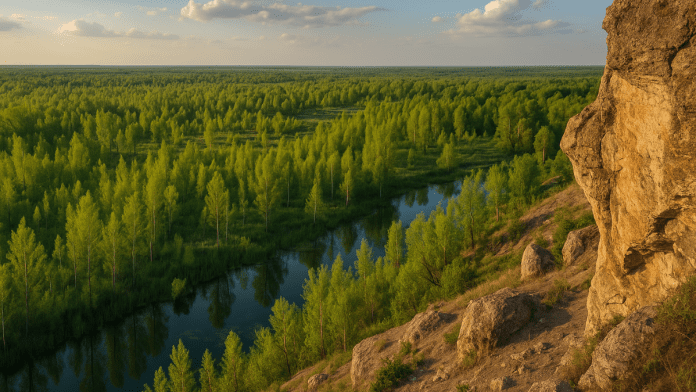🕒 Last updated on July 22, 2025
Two years ago, a huge dam in Ukraine was destroyed during the war. It was called the Nova Kakhovka dam, and it held back a giant reservoir. When it was blown up, water rushed out fast, flooding towns and villages. Many people lost their homes, and some lost their lives. The land that had been under water for over 60 years was suddenly dry again.
A Forest Rises from the Flood
That land, once called the “Great Meadow,” had been flooded back in the 1950s to create the reservoir. Now, for the first time in decades, it has reappeared. And something amazing has happened. A giant forest is growing where the water once was. Young willow and poplar trees stretch for miles. Birds are nesting. Fish are swimming in shallow streams. Animals like wild boars are returning. Even some rare and endangered species are coming back.
This new forest wasn’t planted by people. It grew on its own. Experts say that up to 40 billion tree seeds may have sprouted. The area is now one of the largest natural floodplains in Europe. It’s like nature hit a reset button. The land is healing itself, creating a wild, green space full of life.
A Hidden Danger Beneath the Beauty
But while the forest looks peaceful and full of life, danger still lies beneath the surface. Before the dam was destroyed, the reservoir held not only water but also a thick layer of toxic mud. Over many years, pollution from factories flowed into the water and sank to the bottom. These pollutants include heavy metals like mercury and lead. They can be harmful to both animals and humans.
💥 Ukraine’s darkest night—Ivano-Frankivsk endures largest missile & drone barrage yet
When the dam broke, this toxic mud was released. Now it’s spread across the land. These toxic materials are invisible, but they can get into the soil, plants, and even the animals that eat those plants. If humans come into contact with it or eat animals that have been exposed, they can get sick. Some experts compare these dangers to radiation. Even tiny amounts can cause big health problems, like cancer or lung disease.
The worst part is, it’s hard to check how bad the pollution is. The area is still dangerous because of mines and ongoing fighting. Scientists say there isn’t enough safe access to study the area properly. No one knows exactly how much poison is in the soil or how it might affect people and wildlife in the future.
Nature’s Comeback Faces a Risk
Right now, this new forest is something rare and special. It’s one of the biggest examples of nature growing back all by itself after a human-made disaster. The plants, animals, and birds are slowly returning. Some fish species, like sturgeon, haven’t been seen in this part of the river for 70 years—but now they’re back. Birds are singing in the reeds, and green life covers the dry earth.
But this return to life may not last. Some officials want to rebuild the dam and bring back the reservoir. They say it would restore the energy supply and return things to the way they were before. If that happens, the forest would be flooded again. All the new trees, animals, and wetlands would disappear.
The land that has become a symbol of nature’s strength and healing is still at risk. While life is growing above, there are dangers hidden below. What began as a disaster has become a powerful story of recovery—but it is also a warning. The land is showing us what is possible, but it also holds the memory of what was lost.

